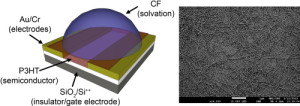 Our researchers with collaboration of colleagues from MRL laboratory and IJS scientists, found a novel and efficient method used to improve carrier mobilities of poly(3-hexylthiophene) (P3HT)-based organic field effect transistors by means of nanowire formation. The treatment, termed solvation, consists of depositing a small quantity of a solvent directly on top of a previously deposited semiconducting film, and allowing the solvent to evaporate slowly. Such treatment results in an increase of the saturation mobility by more than one order of magnitude, from 1.3 × 10−3 up to 3.4 × 10−2 cm2/Vs, while devices preserve their high ON/OFF ratio of ∼104. The atomic force and scanning electron microscopy studies show that solvated P3HT layers develop a network of nanowires, which exhibit increased degree of structural order, as demonstrated by micro Raman spectroscopy. The time-of-flight photoconductivity studies suggest that higher hole mobility stems from a reduced energy disorder of the transporting states in these structures. More can be found in this paper.
Our researchers with collaboration of colleagues from MRL laboratory and IJS scientists, found a novel and efficient method used to improve carrier mobilities of poly(3-hexylthiophene) (P3HT)-based organic field effect transistors by means of nanowire formation. The treatment, termed solvation, consists of depositing a small quantity of a solvent directly on top of a previously deposited semiconducting film, and allowing the solvent to evaporate slowly. Such treatment results in an increase of the saturation mobility by more than one order of magnitude, from 1.3 × 10−3 up to 3.4 × 10−2 cm2/Vs, while devices preserve their high ON/OFF ratio of ∼104. The atomic force and scanning electron microscopy studies show that solvated P3HT layers develop a network of nanowires, which exhibit increased degree of structural order, as demonstrated by micro Raman spectroscopy. The time-of-flight photoconductivity studies suggest that higher hole mobility stems from a reduced energy disorder of the transporting states in these structures. More can be found in this paper.
Archives
- May 2025
- July 2024
- March 2024
- August 2023
- June 2023
- November 2021
- April 2021
- March 2021
- January 2021
- December 2020
- September 2020
- May 2020
- December 2018
- November 2017
- September 2017
- August 2017
- March 2017
- January 2017
- October 2016
- June 2016
- October 2015
- March 2015
- October 2014
- April 2014
- January 2014
- June 2013
- May 2013
- January 2013
- September 2012
- July 2012
- June 2012
